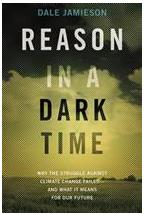87 F. high in the Twin Cities Friday.
83 F. average high on August 1.
83 F. high on August 1, 2013.
August 1, 1831: Cold outbreak across Minnesota with light frost reported at Ft. Snelling.

Maybe I’m Amazed
Weather is the pond in which we live, an atmospheric aquarium in which we’re all bewildered spectators. As in life, weather is cyclical – the background hum of daily changes the soundtrack of our lives.
Which is a long, poetically-tortured way of saying I’m looking forward to hearing Paul McCartney rock Target Field tonight. The man is prolific and hopelessly gifted. And thinking about the arc of his amazing career made me consider all the songs ever written about the weather. Hundreds? Thousands? From classical to jazz, blues & country – artists write about their experiences.
We change our minds, our jobs, even our friends & spouses, but we can’t come close to changing the rhythm and rhyme of the weather. Personally, I find that humbling…and reassuring.
Oh yeah, odds favor a dry sky this evening; today the drier, sunnier, warmer day of the weekend. An irritable warm front sparks swarms of T-storms next week; southern Minnesota will see the heaviest rains by midweek.
So, my love, listen to what the man said. With a little luck this band on the run will temporarily control the elements floating overhead and we’ll all be treated to a few more silly love songs.
Sounds good.
Photo credit above: “Sir Paul McCartney performs with his band during the “Out There” Tour at the Times Union Center on Saturday, July 5, 2014, in Albany, N.Y.” (Photo by Hans Pennink/Invision/AP).
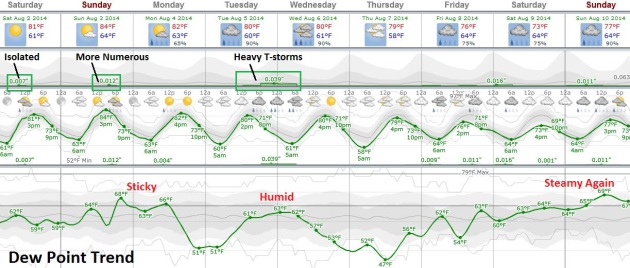
Spotty Weekend Storms, Especially Sunday PM. Long-range guidance shows a lake-worthy weekend, a few isolated T-storms can’t be ruled out today (due to lingering instability aloft). More numerous storms are likely to bubble up late tomorrow ahead of a slightly cooler front. That front stalls, sparking another wave of potentially heavy showers and T-storms late Tuesday into Wednesday morning, especially over southern Minnesota. The latest ECMWF model run shows cooler weather by the end of next week.

Stagnant Pattern = Carolina Flooding. 60-hour NOAA WRF accumulated rainfall amounts are impressive from the Carolinas into Washington D.C., Wilmington and Philadelphia, with some 3-6″ amounts possible over thhe Carolinas, maybe 2-3″ from D.C. up I-95 into the Delaware Valley. Monsoon storms flare up over the southwestern USA with a scattering of storms across the Upper Midwest. Animation: HAMweather.
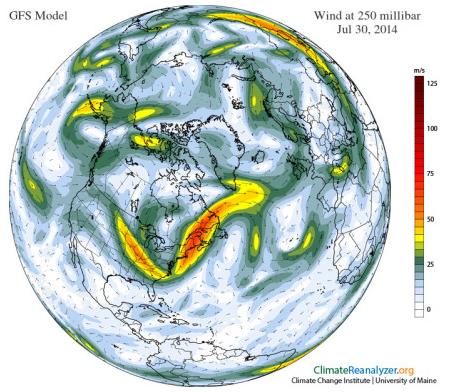
Jet Stream So Weak Winds Are Running From Pacific To Atlantic Across North Pole. Yes, the jet stream is confused, and I still suspect it has something to do with differential heating from the equator to the poles, and rapid warming of the arctic and far northern latitudes. Robert Scribbler explains: “…But, during recent years, temperatures in the far north have been rapidly rising by in some cases as much as 0.5 to 1.0 degrees Celsius per decade. This heating of the polar zone, together with land and sea ice loss, has resulted in a weakening of the circumpolar wind pattern called the Jet Stream. This weakening has collapsed the wall keeping southerly winds from rushing over the Arctic as we see today. The current pattern involves an extreme weakness and high amplitude wave in the Jet Stream extending from the Central Pacific and into the Arctic, extending well above the 80 degree North Latitude line…”
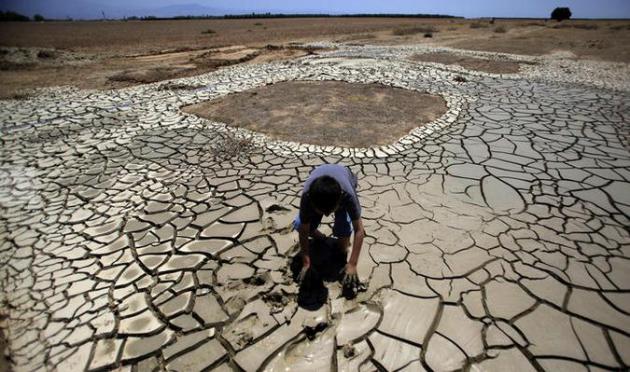
California Breaks Drought Record as 58% of State Hits Driest Level. The same perpetually “stuck” jet stream configuration that sparked record floods in the eastern USA is holding fast with a stalled ridge of hot, high pressure straddling the western USA and western Canada, resulting in a rash of early wildfires and some of the driest conditions on record. Here’s a clip from The Los Angeles Times: “…According to the U.S. Drought Monitor report, in July roughly 58% of California was considered to be experiencing an “exceptional” drought — the harshest on a five-level scale.
Photo credit above: Bob Chamberlin / Los Angeles Times. “Brandon Arthur, 10, crawls out of the gooey muddy tailings left by his father Steve Arthur’s water well drill site in Terra Bella.”

Record-Setting Drought Intensifies in Parched California. More perspective on the slow-motion natural disaster playing out on the left coast from Climate Central; an excerpt: “…While the drought can’t be directly linked to climate change, the warming of the planet is expected to make already dry places drier. And future droughts could be even worse. The current drought — which rivals the terrible drought of the late 1970s — has been 3 years in the making, as three successive winter wet seasons went by with below-normal rainfall. The paltry snowpack this year really intensified matters, and the persistent pattern of heat in the West and cold in the East has kept much of California baking all year. In fact, the state had its warmest first six months of a year on record this year. July has followed suit with, for example, San Francisco registering an uncharacteristic 90°F on July 25, a full 12°F above normal…”
Image credit above: “The progression of the drought in California through the spring and summer of 2014, as the two highest categories, extreme and exceptional drought, grew.”

FDA Offers Hurricane Preparedness Tips. Long Island’s Newsday has an article with some good reminders for preparation, especially as it relates to water and food; here’s an excerpt: “…The U.S. Food and Drug Administration has issued its hurricane preparedness fact sheet for 2014. Among the recommended tips: Store a three-day supply of bottled water for each person in your household; one gallon of water per person per day. Also, now is a good time to inspect the cans of food in your pantry. Replace any rusted or swollen cans…”
Image credit above: “The FDA advises storing a three-day supply of bottled water for each person in your household — one gallon of water per person per day.” (Credit: FDA).
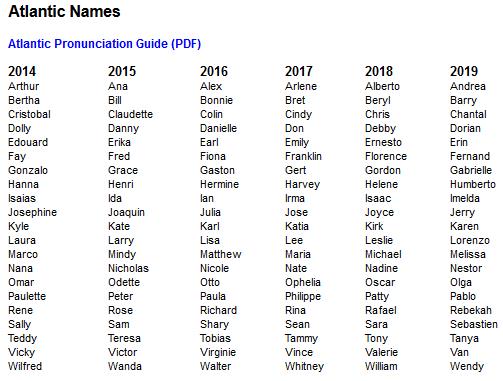
Where Do Hurricane Names Come From? This question comes up from time to time, and I thought KBTX.com in Bryan/College Station, Texas did a good job answering it; here’s an excerpt: “…There are six rotating name lists for the Atlantic Basin,” said Dr. Rick Knabb, Director of the National Hurricane Center. “Every six years you come back to the same list of names that you had 6 years ago, minus any names that were retired after a particular storm caused a level of damage, a scope of human suffering or some other notoriety that made it insensitive for us to hold onto that name,” explained Knabb. Storms like Hurricane Katrina that hit New Orleans and Sandy that impacted the East Coast and Andrew that forever changed how we prepare for hurricanes. Those names have all been retired…”

NOAA’s Hurricane Hunters Due For Overhaul. Imagine your worst flight ever. Now multiply that by 50. That’s what flying into a hurricane is like; unimaginable turbulence. Here’s a clip from an interesting story at SunSentinel: “After pounding through 183 hurricanes over the past 38 years, two Lockheed WP-3 Orion turboprops are almost ready for the junk heap. Yet new hurricane hunters could cost a prohibitive $300 million. Thanks to Hurricane Sandy, the National Oceanic and Atmospheric Administration has another option: Revive both planes with new wings, engines and avionics at a cost of about $15 million per aircraft. That should keep them flying through 2030, or for more than 50 years…”
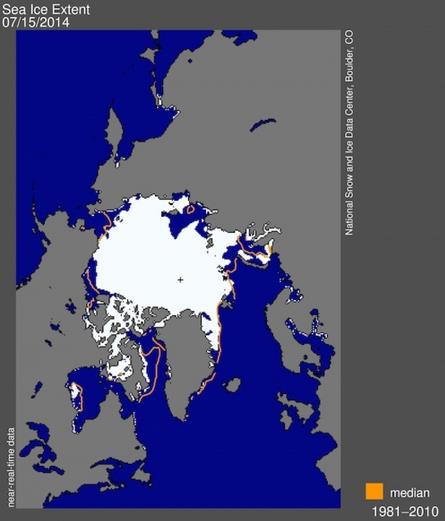
No Record, But Arctic Sea Ice WIll Be Among 10 Lowest. Here’s the introduction to a story at Climate Central: “The extent of sea ice covering the Arctic Ocean at the end of the summer season likely won’t surpass the record low of 2012, but 2014 will still likely rank as one of the lowest minimum extents (or areas) in the record books. That’s according to Julienne Stroeve, a scientist at the National Snow and Ice Data Center in Boulder, Colo. “It’s likely that it will be among the top 10 lowest,” Stroeve told Climate Central in an email…” (Image credit: National Snow and Ice Data Center, Boulder, CO.)

Picture This: Eerie Wildfire, Stirring Rainbow & Sharknado! Climate Central has a grab-bag of interesting weather nuggets and photos, including this beauty; here’s an excerpt: “…It would be hard to find more stunning scenery as the backdrop to an ethereal double rainbow. Double rainbows, like single rainbows, often form after storm weather when the sun’s light is reflected off the back of a raindrop, only in this case, it is reflected twice. This rainbow was photographed above Oregon’s awe-inspiring Crater Lake in the eponymous Crater Lake National Park after thunderstorms swept through the area. (Those same storms spawned lightning that ignited many of the wildfires that have burned across Oregon in recent weeks.)…”
Image credit above: “A spectacular double rainbow photographed after a thunderstorm over Crater Lake in Oregon.” Credit: David Grimes/Crater Lake National Park
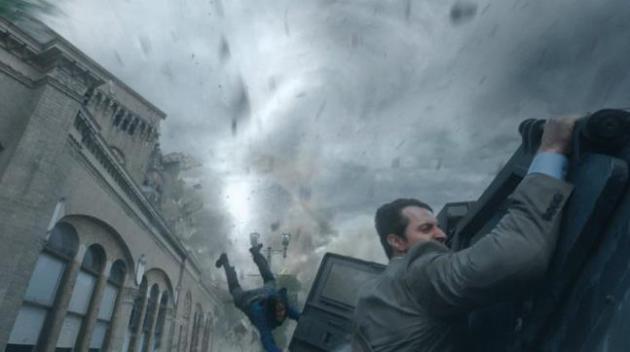
How “Into The Storm” Built a Better Tornado on a Budget. I know it has no resemblance to reality (anytime soon, God-willing) but I am looking forward to seeing this film. A worthy sequel to “Twister”? I’m keeping an open mind. Here’s a clip from The Hollywood Reporter: “While visual effects budgets on summer’s biggest movies can push $100 million, New Line’s upcoming tornado pic Into the Storm defied the odds. Despite unleashing dozens of CG-rendered twisters, it was produced for a thrifty budget of $50 million. Of that, only about $23 million was spent on visual effects, the key selling point of Warner Bros.’ Aug. 8 release…”
Image credit courtesy of Warner Bros. Entertainment Inc.
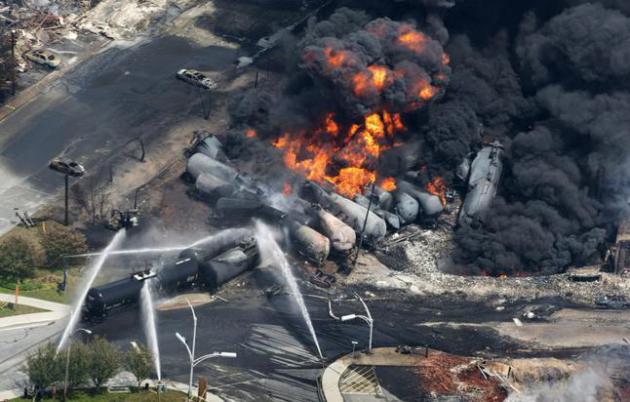
Crude Gamble: Oil-By-Rain Threatens Safety of People and Planet in Pacific Northwest. EcoWatch has the story – here’s the introduction: “With an estimated 9 million barrels of crude oil moving over rail lines in North America at any given moment, it’s no wonder that safety and environmental ramifications of oil-by-rail are top of mind for many. In the wake of the one year anniversary of Quebec’s Lac-Mégantic fatal train derailment explosion, it’s imperative that more people become aware of the dangers of unprecedented amounts of oil being transported through the heart of communities and cities in the U.S. and Canada. Bomb Trains: The Crude Gamble of Oil by Rail, a video produced and published this week by VICE News, investigates the rapid expansion of oil-by-rail transport…”
File photo credit above: “This July 6, 2013 file photo shows smoke rising from railway cars carrying crude oil after derailing in downtown Lac Megantic, Quebec. A string of fiery train derailments across the country has triggered a high-stakes and behind-the-scenes campaign to shape how the government responds to calls for tighter safety rules.” AP Photo/The Canadian Press, Paul Chiasson, File.
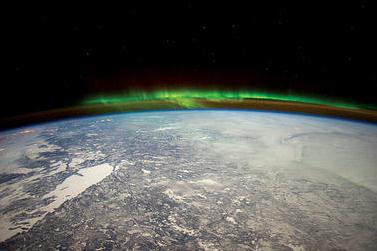
NASA Validates “Impossible” Space Drive. Wired UK has the intriguing article; here’s the introduction: “NASA is a major player in space science, so when a team from the agency this week presents evidence that “impossible” microwave thrusters seem to work, something strange is definitely going on. Either the results are completely wrong, or Nasa has confirmed a major breakthrough in space propulsion. British scientist Roger Shawyer has been trying to interest people in his EmDrive for some years through his company SPR Ltd. Shawyer claims the EmDrive converts electric power into thrust, without the need for any propellant by bouncing microwaves around in a closed container...” (Image credit: NASA).

Poison Yourself – It’s Good For You. Here’s a headline I thought I’d never see; an excerpt from Outside Online: “…“Everybody thinks oxidation is bad, and that antioxidants are good,” says Dr. Philip Hooper, an endocrinologist at the University of Colorado Anschutz Medical Campus. “That’s bogus. A little bit of poison is good.” That poison can actually come from plants, especially those that have survived harsh conditions. In this Nietzschean diet principle know as xenohormesis, foods that have survived harsh conditions make us stronger by stressing our bodies, not because they’re rich in antioxidants…”
Photo credit above: “Ditch the multivitamin and grab the good stuff.” Photo: mythja/Thinkstock.

TODAY: Warm sun, isolated T-storm. Winds: SW 7. High: 83
SATURDAY NIGHT: Clearing, warm and pleasant. Risk of a Beatle. Low: 65
SUNDAY: Sunshine thru afternoon. Late-PM storms likely. High: 86
MONDAY: Partly sunny, slightly cooler. Wake-up: 63. High: 80
TUESDAY: Some sun, heavy T-storms late. Wake-up: 59. High: near 80
WEDNESDAY: Heavy T-storms southern MN. Sunshine north. Wake-up: 61. High: 78
THURSDAY: Intervals of sun, sticky. Dew point: 61. Wake-up: 59. High: 82
FRIDAY: Unsettled, Risk of T-storms. Wake-up: 60. High: 79
Climate Stories…

New Study Indicates Dramatic Fall-Off In Global Crop Yields By The Year 2050. The reason? Warming temperatures increase low-level ozone production, which is even more harmful to crop yields. Here’s an excerpt from Gizmag: “…For example, an estimated 46 percent of damage to soy crops previously believed to have been caused by global warming was reportedly actually due to air pollution. However, whilst the two phenomenon damage the crops in their own right, they are also inextricably linked. The rising temperatures caused by global warming is itself the catalyst that leads to an increase in the creation of plant-damaging ozone. Furthermore, the study highlights that while individually air pollution or global warming would be damaging to global food production capabilities, together they pose a much greater threat, working in concert to detrimentally affect a much wider range of crops than either one could harm on its own…”
File image credit: Shutterstock.

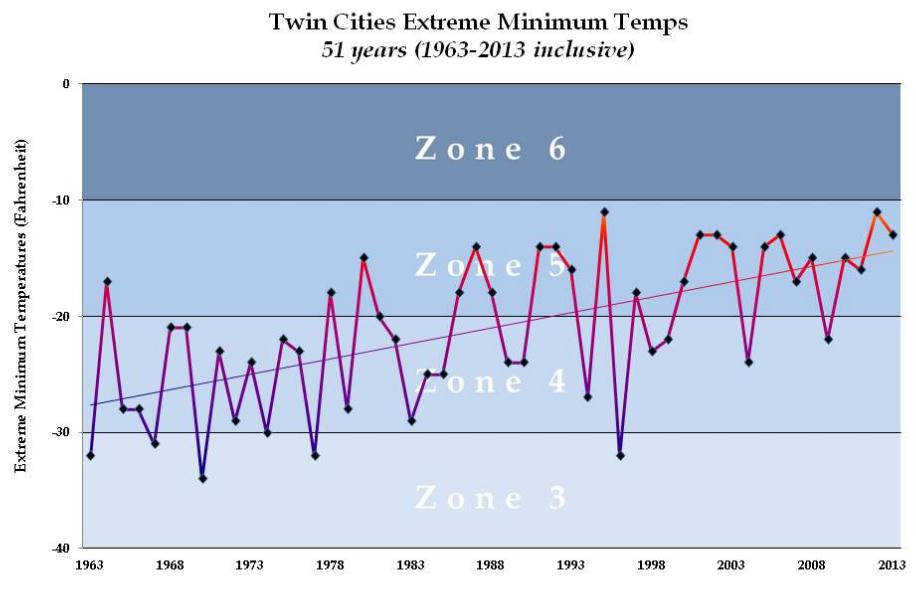
Michael Mann: Public Opinion Critical for Climate Change Fight. Here’s an excerpt of an Op-Ed from climate scientist Michael Mann at The Morning Call: “…Natural gas may not be the panacea some see it as, however. The ramp-up of natural gas development in Pennsylvania, either as an outgrowth of the EPA plan or the continued exploration of the Marcellus Shale, raises the specter of methane emissions from well pads and compressor stations, and methane leakage along the natural gas distribution and delivery chain. More significantly, an uncertain but potentially quite significant additional amount of so-called fugitive methane might escape into the atmosphere during the process of fracking and natural gas recovery. Methane is an extremely potent greenhouse gas, as much as 84 times more potent than carbon dioxide in the first 20 years after its release into the atmosphere…”
Photo credit above: “The $34 million that Dennis Jones paid for his yacht was equal to the $34 million he had donated to charity since 2000.” Photo credit: Thomas Caradonna.

